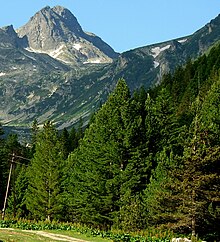| Pinus peuce | |
|---|---|

| |
| Trees in native environment, Malyovitsa, Rila Mountains, Bulgaria. | |
| Scientific classification | |
| Kingdom: | Plantae |
| Clade: | Tracheophytes |
| Clade: | Gymnospermae |
| Division: | Pinophyta |
| Class: | Pinopsida |
| Order: | Pinales |
| Family: | Pinaceae |
| Genus: | Pinus |
| Subgenus: | P. subg. Strobus |
| Section: | P. sect. Quinquefoliae |
| Subsection: | P. subsect. Strobus |
| Species: | P. peuce
|
| Binomial name | |
| Pinus peuce | |

| |
| Distribution range of Pinus peuce | |
Pinus peuce (Macedonian pine[3] or Balkan pine[4]) (Serbo-Croatian and Macedonian: молика, molika; Bulgarian: бяла мура, byala mura) is a species of pine native to the mountains of North Macedonia, Bulgaria, Albania, Montenegro, Kosovo, the extreme southwest of Serbia, and the extreme north of Greece,[5][6][7] growing typically at (600-) 1,000-2,200 (-2,300) m altitude. It often reaches the alpine tree line in this area. The mature size is up to 35–40 m height, and 1.5 m trunk diameter.[5][6] However, the height of the tree diminishes strongly near the upper tree line and may even obtain shrub sizes.[8]
It is a member of the white pine group, Pinus subgenus Strobus, and like all members of that group, the leaves ('needles') are in fascicles (bundles) of five, with a deciduous sheath. They are 6–11 cm long. Its pine cones are mostly 8–16 cm long, occasionally up to 20 cm long, green at first, becoming yellow-brown when mature, with broad, flat to downcurved scales. The 6–7 mm long seeds have a 2 cm wing and can be wind-dispersed, but are also very often dispersed by spotted nutcrackers.[5][6]
The species was first described in scientific literature by August Grisebach in 1844, based on field observations of montane pines on Baba Mountain, above Bitola.[2]
- ^ Farjon, A. (2017). "Pinus peuce". IUCN Red List of Threatened Species. 2017: e.T34193A95751594. doi:10.2305/IUCN.UK.2017-2.RLTS.T34193A95751594.en. Retrieved 19 November 2021.
- ^ a b Grisebach, A., (1844). Spicilegium florae rumelicae et bithynicae exhibens synopsin plantarum, Vol. 2. "Brunsvigae : Vieweg", p. 349, https://mdz-nbn-resolving.de/details:bsb10301664
- ^ BSBI List 2007 (xls). Botanical Society of Britain and Ireland. Archived from the original (xls) on 2015-06-26. Retrieved 2014-10-17.
- ^ Michael Dirr - Dirr's Hardy trees and shrubs: an illustrated encyclopedia, , Timber Press, 1997, ISBN 9780881924046, page. 282
- ^ a b c Farjon, A. (2005). Pines. Drawings and descriptions of the genus Pinus, ed.2. Brill, Leiden ISBN 90-04-13916-8.
- ^ a b c Gymnosperm Database Pinus peuce
- ^ Critchfield, W. B., & Little, E. L. (1966). Geographic distribution of the pines of the World. U.S. Dept. of Agriculture Forest Service Misc. Publ. 991.
- ^ Alexandrov, A. & Andonovski, V. (2011), Macedonian pine - Pinus peuce: Technical guidelines for genetic conservation and use (PDF), European Forest Genetic Resources Programme, p. 6 pp
